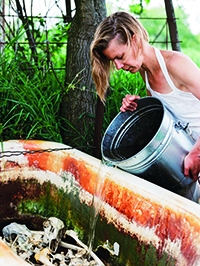Justin Glanville ’97’s short story “Roller Coaster” was published in Kaleidoscope: Exploring the Disability through Literature and Fine Arts (No. 75, Summer/Fall 2017). bit.ly/2ymkVWw

Justin Glanville ’97’s short story “Roller Coaster” was published in Kaleidoscope: Exploring the Disability through Literature and Fine Arts (No. 75, Summer/Fall 2017). bit.ly/2ymkVWw
Molly Martindale ’64 started volunteering with the West Side Christian Parish in Chicago after graduating from Grinnell. In the fall of 1965 she became part of Martin Luther King Jr.’s Chicago Freedom Movement. Her description of some key actions by women on his staff constitutes Chapter 17, “Women in the Movement I: The Women of SCLC-WSCP Take Action,” in the book The Chicago Freedom Movement (University Press of Kentucky, 2016), edited by Mary Lou Finley, Bernard Lafayette Jr., James R. Ralph Jr., and Pam Smith.
Lee Running, associate professor of art, was one of five Iowa artists selected by a panel of Iowa arts professionals to be honored as an Iowa Arts Council fellow for the next year. Each fellow receives access to professional development opportunities, promotional support to enhance their careers, and a $10,000 grant to support new works. Running makes installations and sculptures inspired by natural phenomena, working with animal bones, paper, fabric, fur, raw pigments, and gold.
Jessica Thebus ’88, a theatre artist and director of the Northwestern University M.F.A. program in directing for the stage, directed the Chicago premiere of For Peter Pan on Her 70th Birthday at the Shattered Globe Theatre in April and May. The show was written by Sarah Ruhl, Thebus’ longtime collaborator and a two-time Pulitzer Prize finalist.
Jackie Weissman ’92 wrote “Parenting Outside the Mainstream: Indie Rocker Moms,” a chapter in the anthology Music of Motherhood: History, Healing, and Activism (Demeter Press, 2017). She describes her work making Rock N Roll Mamas, a feature-length documentary about three indie rockers who strive to follow their creative dreams and raise their children. Weissman is also executive director of Oregon Doc Camp, a retreat for experienced documentary filmmakers. Doc Camp is currently embarking on its fifth year.
Rebeka Meyer Pourchot ’94 published this short book about a morning walk through a small Florida beach town, introducing readers to its people and places (CreateSpace, 2017). It includes photos from a single morning.
Greg Borzo ’76 introduces readers to more than 100 outdoor public fountains in his new book Chicago’s Fabulous Fountains (Southern Illinois University Press, 2017). Along with photos by Julia Thiel, he shares short stories about the structures, the artists, and the city, from the serious and historical to the silly and whimsical, such as a pile of bronze dog poo that glistens when wet, to encourage dog owners to clean up after their pets.
David Hechler ’72, an author and editor-in-chief of the legal magazine The Metropolitan Corporate Counsel, published In Good Hands about a South Carolina day care in which two infants died under mysterious circumstances. His book was honored this year by the American Society of Journalists and Authors as the best work of general nonfiction published in 2016. He followed the twists and turns of what proved to be a medical and psychological mystery and also focused on the challenges parents face when trying to ensure that their children in day care are safe. The book is available as a Kindle book on Amazon.
Katie Hail-Jares ’07 is co-editor of Challenging Perspectives on Street-Based Sex Work (Temple University Press, 2017), which brings together academics and people whose lives are impacted by street-based sex work, including police officers, public defenders, foreign aid workers, and sex workers themselves, to discuss policy and new directions for research. The book also inspired an original play, Project Dawn, which was performed in Philadelphia in June and July 2017. The play explores the experiences of women in Project Dawn, a prostitution diversion court in Philadelphia.
Holly Barnet-Sanchez ’69 and her co-author, Tim Drescher, spent 12 years researching, writing, and editing Give Me Life: Iconography and Identity in East LA Murals (University of New Mexico Press, 2016). Chicanismo, the idea of what it means to be Chicano, was born in the 1970s, when grass-roots activists, academics, and artists joined forces in the civil rights movimiento that spread new ideas about Mexican American history and identity. The community murals those artists painted in the barrios of East Los Angeles were a powerful part of that cultural vitality, and these artworks have been an important feature of Los Angeles culture ever since. This book offers detailed analyses of individual East Los Angeles murals, sets them in social context, and explains how they were produced. The authors, leading experts on mural art, use a distinctive methodology, analyzing the art from aesthetic, political, and cultural perspectives to show how murals and graffiti reflected and influenced the Chicano civil rights movement.